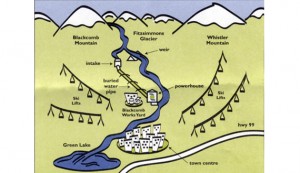http://www.ted.com/talks/jae_rhim_lee.html
It’s been a while since I’ve made a post on here. This was actually a class blog, but, as it seems, there are still some things that make me “get all steamed up”. (You know I still like that line, corny as it is.)
The topic of “decompiculture” is artist Jae Rhim Lee’s idea of a new culture that supports a more holistic, full-circle view of the natural decomposition process – of humans. As weird as it sounds, I can’t tell you how much I’ve thought about the exact same thing. The culture, not to mention gigantic industry surrounding death and funerals and just the whole principle of preserving dead masses is something I’ve stood back from and thought ‘wait…really?’
I think it was a series of conversations and events, and then finally, this video, that led me here. A cousin of mine in the funeral business (cue Italian jokes about having “a cousin in the business”) was talking to me about the new challenges of the casket and larger funeral industry in North America. It seems the funeral industry actually mimics a lot of other older, established, monopolized (or oligopolized) businesses of today, at least in North America. He told me that some staggering percentage of the “lots” are actually controlled by one huge company out of Texas, even the ones in Canada! Then we started getting into what’s involved in personally purchasing a plot; the taxes, the regulation, the maintenance cost on families left behind. Also, did you know that in Europe you don’t buy your burial property, you effectively rent it? Because space is such an issue over there, in some places, you buy a few years (can’t remember exactly how many) of use, and then the graves get dug up and re-used. Whether I actually support digging up graves once they’re in the ground or the situation in Europe is another story – especially the whole idea of going through the motions and continuing with all that pre-burial production, spending, etc, to just dig it all up again a couple of decades later. Seems actually even more ridiculous. However, I also point out that, as usual, at least when you’re thinking from an environmental standpoint, Europe is more ballsy in this case.
However, this brings me back to a culture of decomposition. Why Europe does “go through the motions” is because of the heavy, heavy cultural and religious influences of their citizens, which can also largely vary between countries and be hard to control with unifying policies. Plain and simple, they’re pretty deep-rooted – even telling my Nonna about the idea of cremation gets her going.
However, in my opinion, we’ve got the perfect situation here in North America to actually change and create a new culture, or, movement if you will, around (the somewhat grim and unsexy as far as a movement goes) pre-burial customs. I know these are pretty broad statements to be making, but there are so many diverse backgrounds and viewpoints here, religious and beyond, and not to mention a lot of people with no religious affiliations whatsoever. Because that base there is large enough (the minimum “market size”, if you will), and furthermore, the arguments of practicality, which (yes!) comes largely from the environmental side in this case, is the key to winning even more people over.
So, to encapsulate the concepts I think would be the main drivers of the move towards decompiculture is a hard look at the inputs and outputs of death (there’s no other way to describe it really), and furthermore, tack on a bit of true cost accounting for a common sense, realistic picture.
- casket – Usually made by some gigantic conglomerate, with wood, materials, and the casket itself being shipped across North America. practical: These things can cost thousands of dollars, not to mention can also be incredibly detailed. And then you put them in the ground, never to be seen by anyone again. I know I might be hitting a nerve with some people on that one in terms of “paying respects”, but if you believe in that, then why wouldn’t you believe that that person wouldn’t want you to spend your money on actual living people? environmental: Shipping and construction costs – do you know how heavy a casket is? And the sourcing, materials, detailing, finishing, calls for a lot of back-and-forth.
- body preparation (inputs) – Chemicals, chemicals, chemicals. Really toxic. practical: this thing is going to decompose anyway. environmental: These are really bad for people working with the bodies, from neurological damage to cancer.
- final plot – practical/environmental: Whether that’s in a mausoleum or in a plot outside*, that takes up space. Don’t we have enough density problems concerning living people? practical: Also, you’ve gotta pay an arm and a leg for that space. (No pun intended).
- body preparation (outputs) – This is a main point brought up by Lee, how whatever chemicals absorbed by our bodies either in the course of our lives or just in the course of the body preparation process are released as the body decomposes, or directly when the body is cremated. environmental: Especially when cremated, this stuff is released into the atmosphere. practical: It could be avoided altogether.
After pondering this topic for a while, while I do wonder if a “mushroom death suit” is a truly marketable concept (I have a feeling she hasn’t done a SWOT analysis), it does provide answers for a lot of the problems with modern burials, and could potentially really rock an established industry.
I remember telling my family (and seeing my mom’s horrified face) once that I didn’t want to be buried in a traditional casket or mausoleum. Even so, I’d still think a little harder on whether the “ninja pyjamas” are a real option. The act of “closing the coffin” is a big act of closure for families and loved ones. In addition, with regards to us individually as future users, you could say that the suits are a bit dehumanizing in a way; surrendering us to nature like any plant or animal. While that’s biologically accurate and I don’t argue it, I think it’s tough for us individually to accept that our impact on earth could be washed away so easily.
Anyway, I thought this was a really innovative idea, something not talked about too often, and another great example of the ideas that TED should and does promote; those truly unbounded and unconfined.
Another interesting fact that I found out today: all of Whistler (as in the two mountains and the village) are powered by a 7.9 MW hydro electric dam located on the mountain! In an industry (tourism) traditionally dominated by just an excess of production and consumption, it’s relieving to see that at least the power they’re using is completely sustainable, and produced on-site.
If you’re curious as to where this thing is, here’s a little diagram for you:
I seriously had no idea! It’s also pretty awesome that Whistler’s showcasing its sustainability – you can clearly see it in all its run-of-river glory while riding the Peak 2 Peak gondola. BC Hydro’s also pretty proud of this development – for more information, as well as their take on it, see: http://www.bchydro.com/news/press_centre/media_updates/fitzsimmons_creek_power.html
Original blog post: http://makower.typepad.com/joel_makower/
All right, so I know this guy is supposed to be something of a green business guru, but I’m going to have to be more than the devil’s advocate in responding to this post, and even disagree with his congratulating GM on its “bold move”.
Basically, Chevrolet announced recently that it would invest $40M in purchasing 8M tonnes of carbon offsets. Joel himself acknowledges that the action of buying offsets itself pretty much represents the epitome of seizing the “low-hanging fruit” as they say, and furthermore, that this action is a move typically seen somewhat as greenwashing. However he argues that given the circumstances of GM’s delicate financial position, the fact that their first big move after their rescue was an environmentally-minded one says something extremely significant of the motives of the company. He further states that the funds from these offsets are proposed by GM to spur clean energy projects in the US, as referenced from GM’s VP of Marketing, Joel Ewanwick, and some other general feel-good stuff.
Now, you could say to me that, referencing my earlier blog re: Andrew Souvaliotis, the argument could be made that GM is using their heft and reach to do something good for the masses. However, I counter that with two main points, and the overall conclusion that this is likely a case of straight up greenwashing.
1. Though they are using their heft to make a big accomplishment, GM is not using it to change consumer demand or habits.
- GM is not at all affecting the American consumer’s mindset or purchasing habits. And as we’ve seen through the Air Miles example, it is possible for a company to benefit and profit from changing people’s purchasing habits to ones that promote a widespread sustainability awareness en masse. What GM is doing does not attempt to make lasting change using its business as a vehicle (no pun intended – I realize my blog has quite a few of them) – if it was, they would be investing at least in projects specifically relevant to their industry.
2. GM is motivated to take the heat off of its actual environmentally-minded product offerings.
- Namely, the Chevy Volt, has come under criticism as to whether firstly, it can be classified as an electric car or a hybrid (apparently GM gave the impression it was a purely electric engine which created a lot of hype when it actually wasn’t – debatable as to whether that’s really an issue). Secondly, the actual miles per gallon of the Volt are being debated. Though GM apparently released a number of 40 (from the battery separate from when the gas kicks in), there has been speculation pointing to lower numbers (around 32*). In addition, there is further debate as to whether mpg is even a good measure of the performance of a vehicle whose focus is environmental – there are other things to consider, such as carbon footprint, as this article states: http://www.dailyfinance.com/story/autos/chevy-volt-mpg-rating/19574322/). Apparently the third party regulator for cars in the States, the Environmental Protection Agency, is still coming up with the actual rules for these types of vehicles, so currently, there is no standard of minimum mpg for electric or hybrid cars that consumers can compare to. Therefore, it’s in GM’s best interests not to draw any attention to the fact that they have no real third-party verification for whether the Volt’s mileage is legit for an electric vehicle.
Therefore, my overall conclusions about this blog post and GM’s recent decision do include the fact that GM does see environmental action as high on its priority list. However, purchasing a bunch of offsets is definitely the easiest and least authentic way to take on this mandate, and, as Joel Makower suggests, timing of this decision is everything. The fact that they choose now to invest in an-overly obvious green endeavour when their environmental offerings possibly aren’t taking off as well as they ought to is very interesting. Furthermore, there’s the fact that, being GM and bloody huge, they have the opportunity to just do so much more. Going for this “quick win” in my opinion, doesn’t make a statement about a long-term commitment to sustainability as Makower suggests, but in fact makes this action look extremely reactive, and further, makes GM look like it doesn’t even have confidence in its own environmental initiatives.
In summary, then this is greenwashing at its finest.
Not only did this catch my attention on it’s own, but I was also tagged by Dave in a Facebook post, so I figured I’d reply via blog.
Here’s the original TED talk David’s talking about in his post: http://www.ted.com/talks/john_hardy_my_green_school_dream.html
Basically, it’s a primary school in Bali which has been designed so that every aspect is in some way “green” – examples include a completely bamboo structure, a cow for a lawn mower, and all locally sourced food. The premise behind the school has a lot of components which I really liked. The first one being that it’s international, so kids get to learn from kids from all over the world, though 25% of the school must be Balinese in an effort to support development and education in the area. The school also does this through its local sourcing of food, materials, and labour. The other thing is its holistic learning approach. In addition to the regular teachings of elementary school, kids are also introduced right away to fundamental sustainability issues through hands-on incorporations in lesson plans. I think exposing kids to these issues, as well as an international environment are some of the best tools to equip them later in life. (Though I obviously don’t have my own experience or a well-founded opinion on raising kids, I feel that those aspects introduced to me earlier as a child would have served me well.)
I would totally consider sending my future children to the school, maybe for a year or two. And that also means I would get to live in Bali. Score.
This is actually an old comment (note the Oct 19th date) that I accidentally made on Brandon’s blog instead of my own. Blog noob moment.
Anyway, here ya go!
——————————————
meldelucch says:
Whoa, I had no idea! This is pretty cool.
I’ve thought frequently about the amount of waste professional sports use, often while at hockey games, and it seriously blows my mind. From the World Cup using at least 40 balls per game, to the amount of food waste just generated by the fans watching. And don’t even get me started about the fireworks at home runs during American baseball games. In the NHL’s case, what I’m curious about is whether these green initiatives are more operations focused (e.g. the LEED certification, energy efficiency, etc) or whether they have actually fundamentally certain aspects of the League, as opposed to just finding substitutes. While LEED certification and operational improvements are great and surely a step forward, there are some initiatives that are more low-hanging fruit than others. The real indicator in my opinion are initiatives that actually require changing the values of an organization, and possibly going without something previously thought of as fundamental. For example, is it really necessary for hockey players to have a new jersey every game? With this example specifically, as well as others, I personally think being more sustainable promotes tradition. In the past, hockey wasn’t as glamorized and flashy as it is now. I think cutting back on a few of the frills of the NHL would be more true to the spirit of the game.
Another example: yearly playoff towels. Seriously, I probably have about 6 Canucks playoff towels just myself, my family probably has over a dozen in total. Instead, I love the idea of everyone just bringing all shapes and sizes of plain white towels from their houses, like in the old days. That’s actually fan-generated TRUE spirit and excitement. How can you really measure fan support when they make it harder for you not to participate?
So, in summary, I applaud the NHL’s effort, because I don’t know of any other sports league taking steps like these, but I question how much of a values shift this actually is, as opposed to an easy and well-advertised substitution.
(original post: https://blogs.ubc.ca/markiwsustainability/2010/10/07/the-nhl-making-a-push-toward-sustainability/#comments)
This past weekend I had the privilege of hearing Andrew Souvaliotis, the Chief Impact Officer (how sweet of a title is that?) of AIR MILES for Social Change, speak in my 486R class. His discussion was basically centered on the very point of our class, which made me extremely excited and eager to share his lessons with all of you.
Firstly, AIR MILES for Social Change is the social venture of Air MILES, meaning it’s affiliated with AIR MILES and contributes to the bottom line; however it is operated as a separate business with a social objective. Their contribution to the parent company in terms of the bottom line is marginal because of AIR MILES’ huge revenues, therefore, this actually leaves them with the perfect business model to “choose impact over profit”, as he put it. In terms of the benefits for Air MILES, they have been immeasurable brand impacts from Andrew’s work.
Andrew started the business from an idea that he literally thought of while sitting in his backyard – this is the idea that 1) climate change is a big deal and 2) Canadians are literally obsessed with points. Customer loyalty programs are huge in Canada, the popularity of which are second only to the UK in the world. Andrew thought to combine the ability of a huge company with national impact with incentives driven to change consumer behaviour, and voila, he soon found Air MILES (Air MILES captures over 70% of the Canadian market), sold his company to them, and began his program to make an impact.
The objective of the program, and how Andrew feels businesses should be driving change, is through changing behaviours of consumers. This all lies in the AIR MILES redemption – i.e. when people collect AIR MILES, they have typically been able to redeem them for not only flights, but also a variety of household and other goods. By changing the types of goods people can redeem points for (e.g. bikes, transit passes) and also which goods are eligible for points or extra points (e.g. organic groceries), Andrew is using Air MILES immense national reach and relationships with retailers like Safeway to influence buyer decisions right at purchase. And it actually works! Because of Canadians’ points craze, they’ll seemingly do anything to get a few extra points. Obvious criticisms of this came from the fact that this doesn’t do anything about reducing consumption, and, without key metrics, it can’t be ascertained whether the program is also increasing people’s consumption. Therefore, the AIR MILES for social change program is a definite promoter of the switch over the cut marketing perspective.
Our class asked so many questions that I’d love to elaborate on, however, I wanted to summarize some key themes that I got out of Andrew’s talk.
1. Marketing yourself as “green” is redundant
- Talking about yourself as green just puts you in the huge pool of companies who are doing the same thing – it doesn’t differentiate you from those who see it as a trend. You need to prove you’re green with your actions and let others tell your story for you. (They do this, for example, through the Ontario Power Authority’s proclamations that the AMFSC program grew ROI by 7000x)
2. There has been a fundamental shift in marketing forever – consumers will be permanently aware and affected by environmental and other sustainability issues, and therefore, sustainability will just become mainstream business
- This directly ties into our class debate about whether there needs to be a marketing revolution versus marketing evolution. I definitely agree with Andrew!
3. People are more convinced about climate change when they see its impacts in their backyards (e.g. Stanley Park being destroyed by a windstorm is a more powerful communicator than floods in a far off country)
4. Businesses should not focus on changing their supply to be more sustainable (i.e. sustainable by design) but instead, use their inherent influence and heft to drive change on the demand side (i.e. change consumer behaviour). Only then will climate change be combated, because it has to be something the masses choose to do.
- His argument for AMFSC is that it is transitional in this initiative; by beginning with incentives, they are causing people to change their buying habits. While AIR MILES as a business is continuing to do what it does best, it uses its national reach to drive as many changes in purchasing decisions as it can. Therefore, the best way to drive sustainability as a value is through big business. This perspective resonated the most with me as to what business’ role in driving change actually is. In addition to this, by using your strengths (as a business), and then using that to drive sustainability, you’re creating a real competitive advantage, as opposed one centred on just sustainability, but does not complement the existing strengths of your business.
A last point that I found interesting was the actual ability of loyalty/rewards programs to make money. For anyone wondering about this, as I was, here’s how they do it:
- Loyalty programs are apparently relatively new, and in a market like Canada where we love points, people literally pounce on that.
- How the redemption structure actually works:
- Besides the people that never redeem (free revenue), and the fact that redemption costs for a bike or flight, for example, are less than the revenues they are paid from someone like Safeway to offer the program, the other source of profitability lies in turnover cycles. Basically, they collect accounts receivables from people like Safeway right away, but time to actual redemption (i.e. accounts payables) is typically 30 months away! That’s the equivalent of getting free interest payments. I just about had the equivalent of an accounting orgasm.
Anyway, I’m eager to hear people’s feedback on this guy and hope to debate the issues he raised possibly in our class.
For Andrew’s bio, see: http://www.loyaltyone.com/whoweare/ourleaders.aspx (and scroll down).
Press release about the AIR MILES for Social Change program: http://www.loyaltyone.com/whoWeAre/NewsReleasesItem.aspx?id=69bf9027-9d65-401a-9eb2-bcfee4ee3187
The attached report, “British Columbia’s Green Economy: Securing the Workforce of Tomorrow”, published recently by the Globe Foundation, lays out how its rapidly growing green job market could very well be BC’s comparative advantage. The report outlines six key sectors which generated 166,000 full time-equivalent jobs in BC in 2008, and that number is expected to increase to a possible 202,000 by 2020. So, for anyone looking for sustainability-related careers or not, the reality is that BC’s economy is going to be increasingly affected by the green economy. Over 10% of BC’s GDP in 2008 (that’s $15.3 billion) was created through our six key green sectors, and is projected to grow to over 14% ($27 billion) by 2020.
These six sectors include:
- Clean and Alternative Energy (44%)
- Energy Management and Efficiency (11%)
- Green Building (14%)
- Environmental Protection (21%)
- Carbon Finance and Investment (1%)
- Green Knowledge, Research, and Support (9%)
All of these sectors combined are growing faster than BC’s economy on the whole.
REPORT: globe_green_economy_report_ii_final
For reference, the Globe Foundation is:
The time has come!
For the third year in a row, Chasing Sustainability continues to be, dare I say it, Sauder’s most valuable conference. I’m allowed to say that because it’s my blog, but also, when you look at all it offers, I really think I’ve got it on this one.
- 4 top-quality speakers that make it worth it already (including a member of KPMG’s Global Sustainability Steering Committee and a green marketer who’s worked with Unilever, P&G, Molson, and Translink, and someone in social investing from Vancity!)
- A sure-to-be-steamy panel discussion – seriously, this is your chance to grill CANFOR, and then see what someone from the BC Ministry of Environment has to say about it. you know I’m all over it.
- An interactive case discussion – if you’re in first or second year, this is a great way to get a head start on the best way to learn; bounce your opinion off of passionate students from backgrounds outside of Commerce, MBAs, and business delegates
Last but not least, it’s ten dollars. ten freakin’ bucks. My finance side is foaming at the mouth. Too much info perhaps, but seriously, how can you argue with that value per dollar? 10 bucks can’t even get you the free lunch that’s provided, let alone the insane speaker line-up, but more importantly, a real chance at challenging your learning and opening yourself up for an invigorating, non-typical, eye-opening experience.
If you need to be further convinced, check out the conference package: http://cussustainability.com/wp-content/uploads/2010/10/Chasing-Sustainability-Conference-2010.pdf
and also the CUS Sustainability website: http://cussustainability.com/conference/ (Under the Conference tab)
Hey there,
Welcome to my COMM 486F blog. I thought of naming it this way not only because there are a lot of handy tea-themed puns one can make when talking about sustainability, but because this is a place where I’ll be posting “when I get all steamed up” (excited, upset, celebratory, depressed) about anything to do with sustainability. So, you can expect a variety of “flavours” of posts, links, and stories that will hopefully be worth a good steep.
Enjoy!







